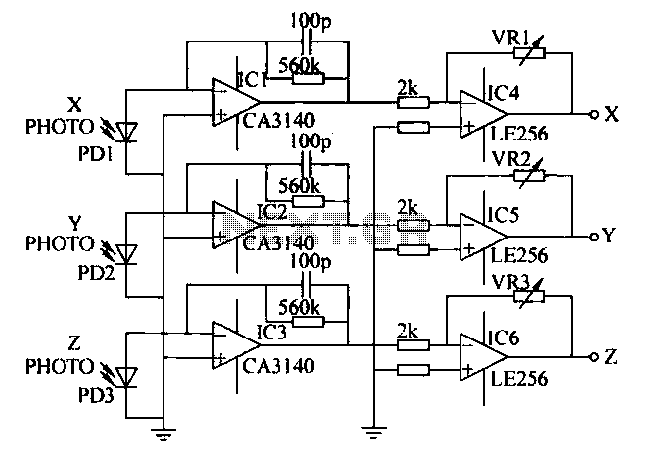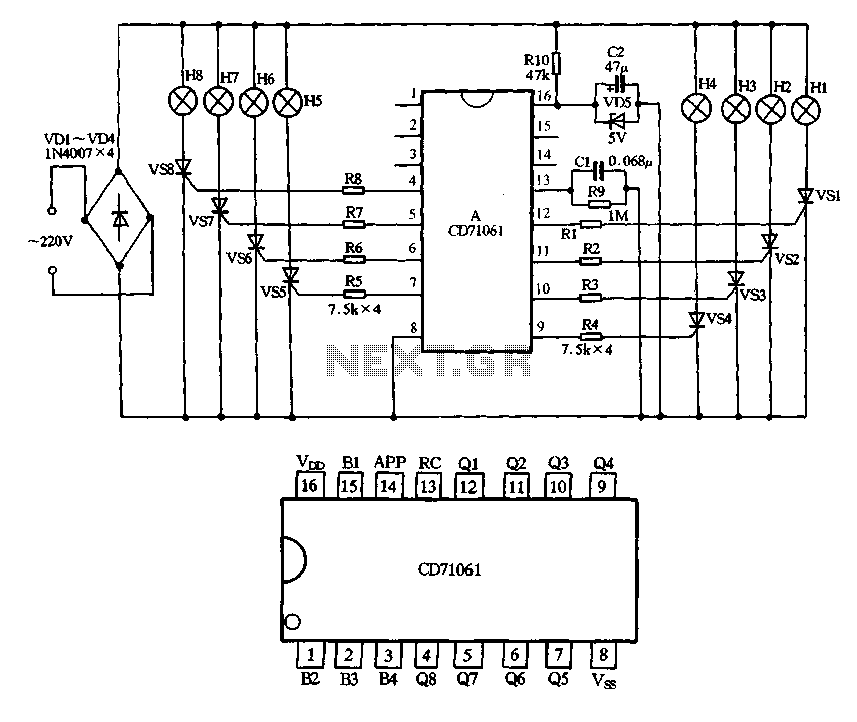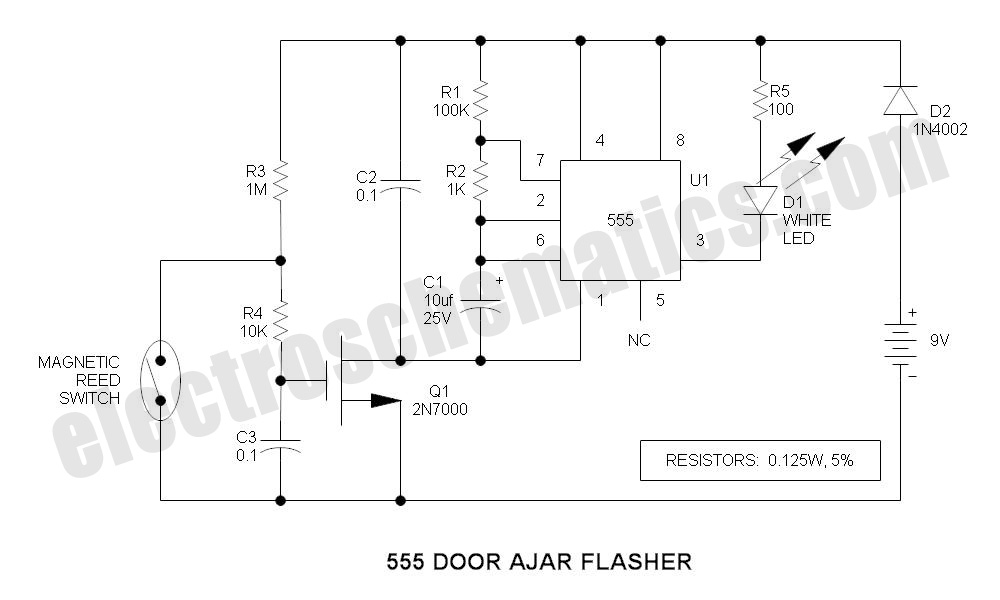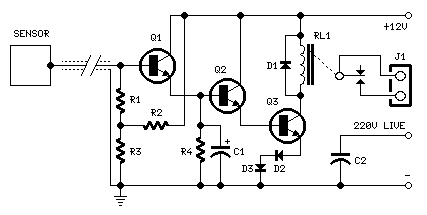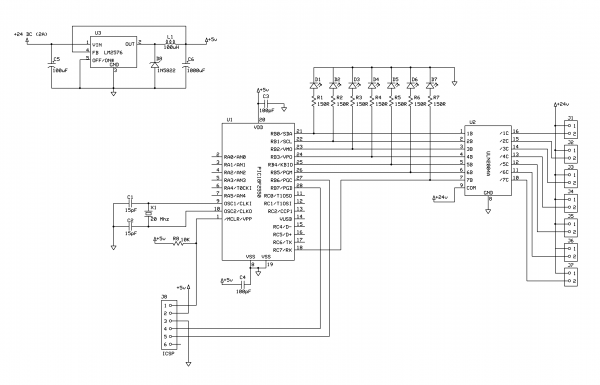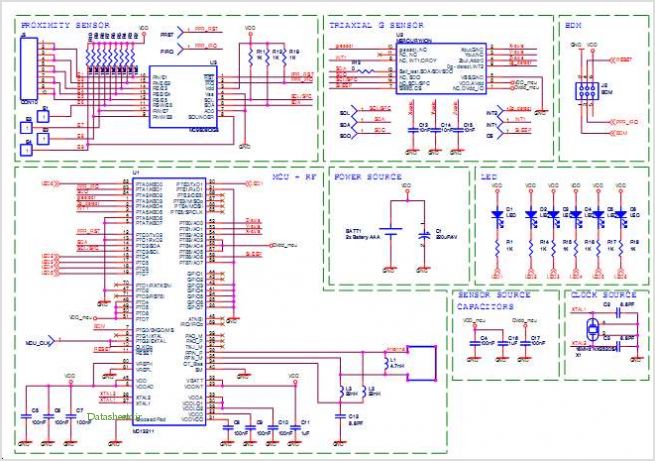
AUDIBLE LIGHT SENSOR
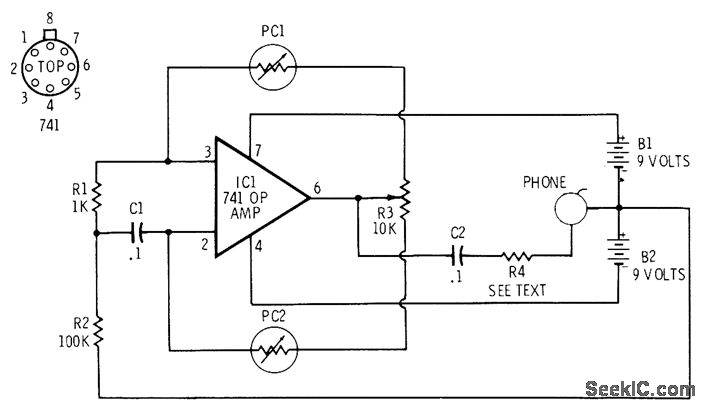
The 741 operational amplifier is configured as an audio oscillator using Radio Shack 276-677 photocells in the feedback circuits. When light strikes photocell PC1, its resistance decreases, resulting in a corresponding decrease in the frequency of the audio tone heard through the headphones. Conversely, when light strikes photocell PC2, which is connected to the non-inverting input of the 741, an increase in illumination leads to an increase in frequency. A resistor, R4, is selected to adjust the volume to the desired level, while R3 serves as a balancing control for the photocells.
The circuit utilizes a 741 operational amplifier (op-amp) configured to function as an audio oscillator, generating sound frequencies that can be modulated by varying light levels. The key components include two photocells (PC1 and PC2) that serve as light-dependent resistors, which change their resistance based on the amount of light they are exposed to.
In this setup, PC1 is connected in such a way that as light intensity increases, its resistance decreases, leading to a reduction in the output frequency of the oscillator. This behavior can be utilized in applications where a decrease in frequency corresponds to lower light levels, creating an inverse relationship between light and audio output.
On the other hand, PC2 is connected to the non-inverting input of the op-amp. When the light intensity increases on this photocell, it results in a decrease in resistance, which in turn increases the frequency of the audio tone produced. This setup allows for a dual modulation effect, where one photocell decreases frequency while the other increases it, creating a dynamic audio response to varying light conditions.
Resistor R4 is included in the circuit to control the volume output of the audio signal, allowing for adjustments based on user preference or environmental conditions. Meanwhile, R3 acts as a balancing control for the photocells, ensuring that their responses to light are appropriately matched for the desired audio effect.
This circuit exemplifies the use of light-sensitive components in audio applications, providing a unique interface for sound modulation based on environmental light levels. The design is documented in "Integrated Circuit Projects, Vol. 2" by F. M. Mims, which serves as a reference for further exploration of similar electronic projects.741 opamp is connected as audio oscillator with Radio Shack 276-677 photocells in feedback circuits. When light strikes PC1, its resistance decreases and frequency of audio tone in headphone decreases correspondingly. When light strikes PC2, which is connected to noninverting input of 741, increase in illumination serves to increase frequency.
Cho ose R4 to reduce volume to desired level. R3 is balancing control for photocells. -F. M. Mims, "Integrated Circuit Projects, Vol. 2, " Radio Shack, Fort Worth, TX, 1977, 2nd Ed. , p 81-86. 🔗 External reference
The circuit utilizes a 741 operational amplifier (op-amp) configured to function as an audio oscillator, generating sound frequencies that can be modulated by varying light levels. The key components include two photocells (PC1 and PC2) that serve as light-dependent resistors, which change their resistance based on the amount of light they are exposed to.
In this setup, PC1 is connected in such a way that as light intensity increases, its resistance decreases, leading to a reduction in the output frequency of the oscillator. This behavior can be utilized in applications where a decrease in frequency corresponds to lower light levels, creating an inverse relationship between light and audio output.
On the other hand, PC2 is connected to the non-inverting input of the op-amp. When the light intensity increases on this photocell, it results in a decrease in resistance, which in turn increases the frequency of the audio tone produced. This setup allows for a dual modulation effect, where one photocell decreases frequency while the other increases it, creating a dynamic audio response to varying light conditions.
Resistor R4 is included in the circuit to control the volume output of the audio signal, allowing for adjustments based on user preference or environmental conditions. Meanwhile, R3 acts as a balancing control for the photocells, ensuring that their responses to light are appropriately matched for the desired audio effect.
This circuit exemplifies the use of light-sensitive components in audio applications, providing a unique interface for sound modulation based on environmental light levels. The design is documented in "Integrated Circuit Projects, Vol. 2" by F. M. Mims, which serves as a reference for further exploration of similar electronic projects.741 opamp is connected as audio oscillator with Radio Shack 276-677 photocells in feedback circuits. When light strikes PC1, its resistance decreases and frequency of audio tone in headphone decreases correspondingly. When light strikes PC2, which is connected to noninverting input of 741, increase in illumination serves to increase frequency.
Cho ose R4 to reduce volume to desired level. R3 is balancing control for photocells. -F. M. Mims, "Integrated Circuit Projects, Vol. 2, " Radio Shack, Fort Worth, TX, 1977, 2nd Ed. , p 81-86. 🔗 External reference
Warning: include(partials/cookie-banner.php): Failed to open stream: Permission denied in /var/www/html/nextgr/view-circuit.php on line 713
Warning: include(): Failed opening 'partials/cookie-banner.php' for inclusion (include_path='.:/usr/share/php') in /var/www/html/nextgr/view-circuit.php on line 713
